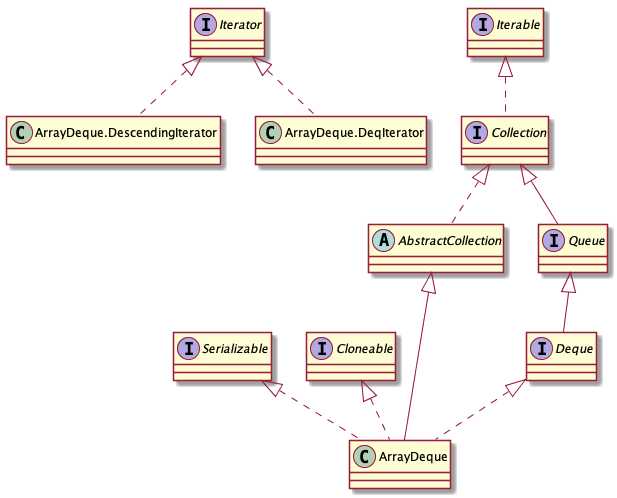标签:源码 最小 info war add src array bool 图片

注意: head和tail是可以在数组上循环的,意即:head和tail不停的在数组上从左向右移动,移动后终点后,再继续从数组的起始位置继续移动。相当于一个环!理解了此处,就可以很方便的理解每个方法。
基于上述内容,可以推理出,tail的位置(在数组上)可能会在head的前面。
//根据元素个数计算出容量大小
private static int calculateSize(int numElements) {
int initialCapacity = MIN_INITIAL_CAPACITY;
// Find the best power of two to hold elements.
// Tests "<=" because arrays aren‘t kept full.
if (numElements >= initialCapacity) {
initialCapacity = numElements;
initialCapacity |= (initialCapacity >>> 1);
initialCapacity |= (initialCapacity >>> 2);
initialCapacity |= (initialCapacity >>> 4);
initialCapacity |= (initialCapacity >>> 8);
initialCapacity |= (initialCapacity >>> 16);
initialCapacity++;
if (initialCapacity < 0) // Too many elements, must back off
initialCapacity >>>= 1;// Good luck allocating 2 ^ 30 elements
}
return initialCapacity;
}
private void doubleCapacity() {
assert head == tail;
int p = head;
int n = elements.length;
int r = n - p; // number of elements to the right of p
int newCapacity = n << 1;
if (newCapacity < 0)
throw new IllegalStateException("Sorry, deque too big");
Object[] a = new Object[newCapacity];
// head和tail的位置,不一定是在数组的起始位置。先将head右边的元素拷贝至新数据
System.arraycopy(elements, p, a, 0, r);
// 将数组起始位置至head位置的元素拷贝至后续位置
System.arraycopy(elements, 0, a, r, p);
elements = a;
head = 0;
tail = n;
}
//注意此处,不是直接将元素放置于head的位置,而是head前面的位置。因为head代表的是头部元素
public void addFirst(E e) {
if (e == null)
throw new NullPointerException();
elements[head = (head - 1) & (elements.length - 1)] = e;
if (head == tail)
doubleCapacity();
}
//注意此处,直接将元素放置于tail位置。tail用于标明下一个尾部元素添加的位置
public void addLast(E e) {
if (e == null)
throw new NullPointerException();
elements[tail] = e;
if ( (tail = (tail + 1) & (elements.length - 1)) == head)
doubleCapacity();
}
public E pollFirst() {
int h = head;
@SuppressWarnings("unchecked")
E result = (E) elements[h];
// Element is null if deque empty
if (result == null)
return null;
//将因素槽位空出
elements[h] = null; // Must null out slot
//head向后移动
head = (h + 1) & (elements.length - 1);
return result;
}
public E pollLast() {
//tail之前的位置
int t = (tail - 1) & (elements.length - 1);
@SuppressWarnings("unchecked")
E result = (E) elements[t];
if (result == null)
return null;
elements[t] = null;
//重置tail
tail = t;
return result;
}
private boolean delete(int i) {
checkInvariants();
final Object[] elements = this.elements;
final int mask = elements.length - 1;
final int h = head;
final int t = tail;
// i 之前的元素个数
final int front = (i - h) & mask;
// i 之后的元素个数
final int back = (t - i) & mask;
// (t -h) & mask 队列的元素总个数
// Invariant: head <= i < tail mod circularity
if (front >= ((t - h) & mask))
throw new ConcurrentModificationException();
// 最小元素移动 若i之前的元素个数大于之后的个数,则将之后的元素向前移动;
// 否则,将之前的元素向后移动。
// Optimize for least element motion
if (front < back) {
if (h <= i) {
/**
* X X X E E E E E E X
* h i t
*/
System.arraycopy(elements, h, elements, h + 1, front);
} else { // Wrap around
/**
* E E E E E E X X E E
* i t h
*/
System.arraycopy(elements, 0, elements, 1, i);
elements[0] = elements[mask];
System.arraycopy(elements, h, elements, h + 1, mask - h);
}
elements[h] = null;
head = (h + 1) & mask;
return false;
} else {
if (i < t) { // Copy the null tail as well
/**
* X X X E E E E E E X
* h i t
*/
System.arraycopy(elements, i + 1, elements, i, back);
tail = t - 1;
} else { // Wrap around
/**
* E X X X E E E E E E
* t h i
*/
System.arraycopy(elements, i + 1, elements, i, mask - i);
elements[mask] = elements[0];
System.arraycopy(elements, 1, elements, 0, t);
tail = (t - 1) & mask;
}
return true;
}
}
public int size() {
return (tail - head) & (elements.length - 1);
}

标签:源码 最小 info war add src array bool 图片
原文地址:https://www.cnblogs.com/zzzzzzzh/p/12775941.html